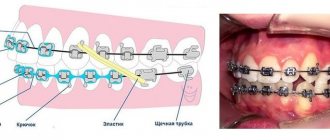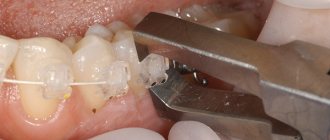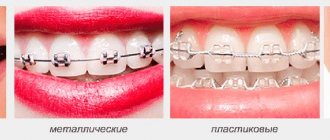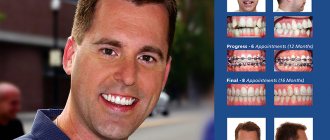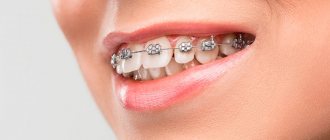Not every patient knows what a combined bracket system is. As a rule, treatment with braces is presented within the framework of the choice of one type of structure. Now you can learn in detail about the combined braces system and, perhaps, reconsider your views on correcting your bite.
A certain percentage of people consider these designs to be optimal for correcting occlusion in terms of price, quality and aesthetics. Speaking about the latter, one cannot help but notice that most often patients try to hide the presence of braces on their teeth as much as possible, sometimes agreeing to lingual braces, which cause a number of serious difficulties in everyday life.
Surely you know that braces are made from different materials. Each of them has a different impact on teeth, strength and appearance. Materials and prices vary. Most often you have to choose between the effectiveness of the treatment and the beauty of your smile, even during treatment. But how to combine the invisibility of transparent braces and the effectiveness of metal ones? More on this later.
Combined braces: indications for installation
Combined braces are selected according to indications:
- Finding a compromise between aesthetics and functionality. It has been proven that metal braces guarantee the maximum effectiveness of treatment, but they are the most unaesthetic and stand out on the teeth. In order not to spoil the beauty of a smile with metal locks, doctors select a different type of brace system for the front teeth, leaving metal for invisible areas.
- Selection for malocclusion pathology. Often, only one jaw needs strong correction—the upper or lower. The second requires less intensive treatment. In this case, doctors recommend installing different orthodontic systems on the upper and lower teeth, which allows you to combine materials or types of devices.
- Patients' financial wishes. Metal structures are not only the most effective, but also inexpensive. Sapphire and lingual braces cost significant amounts. Combining options allows you to save money, get an aesthetically pleasing result during the correction period, and achieve bite correction in a short time.
If we consider strictly the medical indications for installing combined braces, then among them will be:
- pathological bite - open, distal, mesial, deep;
- disproportionate development of the jaws;
- diastemas, trema, large interdental spaces;
- dystopia, incorrect position of individual teeth in the jaw.
Unpleasant moments after installation
Despite all the advantages of such braces, they, like all other orthodontic structures, involve some unpleasant moments after installation.
Almost everyone who has ever been interested in the possibility of getting straight teeth knows about this today. During the consultation, the doctor will once again remind the patient about possible inconveniences during bite correction. Almost everyone experiences discomfort in the first days and weeks after installation. This is due to the unusual constant load and pressure on the teeth that braces exert. Therefore, there is no need to be afraid of an unpleasant moment: the discomfort will pass on its own.
There is also a risk of inflammation of the mucous membrane upon contact with braces and friction, but this can also be solved. Problems with diction are also easy to fix. In general, after a month, all patients get used to braces and stop noticing them.
Combined braces: metal-ceramics and other types
In the photo, combined braces are a combination of metal with ceramics or sapphire clasps. In fact, there are very different combinations. The most popular and in demand among patients:
- Combined metal and ceramic braces. According to pediatric dentists, the optimal combination of materials. Ceramics do not withstand heavy loads well, which justifies its use for front teeth. Metal braces do an excellent job of basic correction, quickly and accurately correcting the bite.
- Combined bracket system made of metal and sapphires. More expensive than the previous option, but even more aesthetically pleasing and comfortable. Sapphires have the ability to adapt to the color of tooth enamel, which makes braces virtually invisible on patients' teeth.
- A combination of the vestibular and lingual systems, which allows you to make bite correction invisible to others. Internal braces are placed on the teeth of the upper jaw row, and metal classics are attached to the lower ones.
Metal braces: photos “before” and “after” treatment
Orthodontists document manipulations in medical records and using a dental photo protocol. The doctor uses photographs to plan and illustrate treatment progress. After the patient has signed consent to the processing of personal data and allowed the photographs to be used for commercial purposes, the orthodontist has the right to post the photo protocol on the Internet.
photo protocol for deep bite treatment
Orthodontists publish “before” and “after” photos of braces treatment on social networks to attract new patients, show the quality of treatment and discuss clinical cases with colleagues.
Why do people come to the Aza&Buka clinic for combined braces?
The installation of combined brace systems has nuances and requires maximum professionalism from orthodontists. Pediatric dentistry Aza&Buka is:
- The work of experienced doctors. Patients are treated by orthodontists of the highest category who have experience working with various materials, systems, and devices.
- Excellent diagnostics and proven treatment regimens. Doctors select combinations of braces taking into account the existing bite pathology, combining the functionality and aesthetics of different materials.
- Selection of orthodontic appliances. The dental clinic offers braces from the best manufacturers - metal, ceramic, sapphire, lingual, vestibular.
A few words about braces
Let's not talk about the cult of the Hollywood smile, which dictates a certain image and lifestyle. Let's just remember that a malocclusion is not only an aesthetic or psychological problem.
Bite pathologies over time have a negative impact on the skeletal system of the jaw, leading to facial asymmetry and destruction of teeth that bear the maximum load when chewing food.
Therefore, it makes no sense to solve the problem of whether to treat or not treat malocclusion. Of course, treat!
Modern braces are used to correct almost any malocclusion at any age.
Depending on the size of the wallet and the complexity of the clinical situation, modern orthodontists often offer their patients to install metal, ceramic, sapphire or lingual braces. Often the patient is offered to use combined braces, consisting of several types of materials. Let’s take a closer look at what’s special about this type of brace system and to whom they can be shown.
Installation of combined braces: stages
Combining braces require a careful approach when treating malocclusion. The correction takes place in several stages:
- Diagnostics
The patient is given CT, OPTG, and TRG images, which guarantees the opportunity to study the structure of the jaws in different projections - to determine the type of pathology and prepare a treatment strategy.
- Taking impressions
Impressions of the patient's dentition are intended to create a diagnostic model and carry out calculations.
- Oral preparation
The patient is treated for all teeth - caries, pulpitis. They also perform professional hygiene to remove plaque and mineral deposits.
- Fixing braces
The doctor attaches braces to the teeth one by one according to the agreed pattern. Usually, aesthetic, inconspicuous plates are placed on the upper teeth, from canine to canine, and metal plates are placed on the upper and lower lateral teeth. Sometimes sapphire and ceramic braces are glued to 12 teeth - to the frontal areas of both jaws.
- Treatment control
Planned appointments are carried out every month - to replace ligatures, orthodontic power arches, and install elastics. And also to check the effectiveness of the correction.
- Retention period
After removing the combined braces, the patient wears retainers, special arches installed behind the 6 front teeth. The task of retainers is to record the result of treatment.
Indications for use
- A compromise between functionality and aesthetics.
In case of significant curvature of the dentition, metal braces are recommended for the most effective treatment, but not everyone is ready to wear them. In this case, you can find a compromise between beauty and benefit by installing different types of systems (according to functional and aesthetic indicators) for the anterior and chewing teeth. - Each jaw has its own braces.
The case when different types of devices are used to correct the bite on different jaws. This is especially true if the lower dentition is more crooked than the upper one, and wearing metal braces is recommended to correct it. And you can safely install a more aesthetic design on your upper teeth. - Financial question.
Metal structures are often recommended for serious anomalies, but bite correction can be successfully corrected using any system. But whether there is enough money for, say, sapphire braces is a big question. In conditions of limited budget, combined systems can serve very well.
Answers to popular questions
What are the “disadvantages” of combined braces?
Combined braces require a little more careful care, as well as careful wearing, since ceramics and sapphires are quite fragile materials. There are no more cons.
Do ligature and self-ligating braces combine?
Yes, but rarely, since there are no special indications for combining systems.
Why don't all orthodontists agree to combine braces?
Connecting different brace systems requires experience and professionalism from the doctor. It also takes longer to install. Aza&Buka dentistry practices the installation of combined braces according to indications and with the consent of the patient.
Why do they put transparent ones in front and metal ones on the sides?
This is justified aesthetically and functionally. The most inconspicuous materials are used in the smile area, and the most effective metal braces work to move molars and premolars.
Can combined braces be used only on the upper teeth?
Yes, sure. In this case, the doctor will place metal braces on the lower jaw.
Did not find an answer to your question?
Which braces are better: popular Ormco models
Here is a brief description of Ormco self-ligating and ligature metal bracket systems.
- Damon Q2 passive self-ligating braces went on sale in 2018. High-precision groove with improved rotation control, increased subligature space for elastic fixation and cap-mounted guides for precise positioning. Damon Q2 is compatible with Damon Q, Damon Clear2 and buccal tubes: the doctor flexibly uses the Damon ecosystem to achieve results. Damon Q2 – reliable metal braces with a high-precision groove.
benefits of Damon Q2
- Damon Q metal braces are Ormco's best seller. Since 2008, a million patients in Russia have been treated using this model. Small size and rounded edges do not rub the mucous membrane. The mesh base secures the braces to the tooth enamel throughout the entire treatment period. Damon Q is a confident choice for an orthodontist.
Damon Q Stainless Steel
- Mini Diamond is a system of metal ligature braces with a universal diamond shape. Using the properties of 17-4 steel and MIM casting technology, Ormco engineers reduced the size of the bracket by 30%. For the anterior and lateral groups of teeth, the doctor can choose zero, standard, low and high torque. Orthodontists fix the Mini Diamond in complex clinical cases that require small sizes and careful control of the position of the teeth. Mini Diamond is suitable for patients on a budget.
Mini Diamond in 17-4 steel
- Orthos – ligature metal braces. For five years, a team of researchers using computer engineering methods developed a design for orthodontists. The result of the work is a “smart” system of braces, arches and buccal tubes, as well as its own recipe. Features of the Orthos prescription are negative torque and progressive positive angulation of lower incisor brackets, reduced values of negative torque in the lateral regions and positive angulation of lower and upper second premolars.
ligature Orthos on typodont
- Titanium Orthos are classic ligature braces made of titanium alloy for patients with allergic reactions to nickel. Models of the anterior group of teeth with a curved shape repeat the surface of the incisors and canines: this makes it easier for the doctor to position the locks during fixation.
- Synthesis – ligature braces enlarged compared to Mini Diamond with precise rotational and angulation control of teeth on a straight arch. The model is suitable for budget treatment.
When comparing types of metal braces, Damon Q2 comes to the fore. The doctor does not waste time removing ligatures or trying to open jammed lock covers. Without making any effort, the orthodontist turns a special “key” and changes the arch without pain for the patient. Elastic chains and rods cling to the enlarged subligature space of the braces. Patients do not waste a single day on their way to a Hollywood smile.
Option for curved lower units
There are frequent cases of severe curvature of the lower teeth, when the upper ones look more attractive. In such a situation, ceramics will not provide the desired straightening effect. For patients with this state of affairs, the specialist recommends the following:
- Use combined designs. For the lower jaw, use metal products, since this is the most durable material.
- Place a structure made of any more aesthetic material on the upper dental organs so that the attractiveness of the smile does not suffer.
General overview
Combined braces are an orthodontic design that uses components made from various materials. There can be many options for such a combination.
One design can use metal, plastic, ceramic or sapphire parts.
In addition to combining different materials, the dentist may suggest installing braces on different sides of the dentition, reducing their visibility without compromising their effectiveness.
Care
To maintain the aesthetic appearance and functionality of combined braces, it is important to adhere to the following recommendations when caring for them:
- if there are plastic elements of the system, it is necessary to limit the use of coloring products as much as possible;
- Avoid putting excessive pressure on braces, especially with ceramic and sapphire parts;
- for high-quality hygiene, use a brush with a V-shaped neckline, a brush, and dental floss;
- brush your teeth and teeth at least twice a day;
- Avoid eating sticky foods and hard foods that can cause locks to come off and deform the power arc.
Hygiene recommendations
Orthodontic structures require more careful and careful hygiene, since it is possible for food debris to get stuck between the individual elements of the structure. To do this, it is recommended to use special brushes and brushes that make cleaning easier, as well as an irrigator that helps to quickly and efficiently clean hard-to-reach places. During treatment, follow-up with a periodontist and regular professional oral hygiene are recommended to prevent gum inflammation and the development of dental caries.
How do braces work?
Correction of defects in the dentition occurs due to pressure on incorrectly located units. The system consists of passive and active elements. The first include locks that are installed on each tooth using dental material. It provides reliable bonding without negatively affecting the enamel. Each lock has a groove for an arc.
The active element in the system is a metal arc that passes through the grooves of the locks, creating a solid structure. It has a unique property - to return to its original position, no matter how bent it is. Before installation, it has the correct shape, which it should take after the end of treatment. Under the influence of its force, the dentition moves in the desired direction, occupying the correct position.
Why combine braces?
Ceramic or transparent products are installed on the front group of teeth, and metal ones are installed on the sides as a base. The choice of such a combination ensures the strength of the structure under heavy chewing loads and high results in correcting defects. The main task of combining braces will allow patients not to pay for beauty where it is not so important. Aesthetic products are needed in the smile area so that a person does not experience discomfort during the treatment period, but on the side, reliability is more important. In this way, it is possible to simultaneously ensure high levels of functionality of the system, reduce the time of wearing braces, the time of correction and preserve the aesthetics of the dentition.
There are no transparent arcs that would be invisible; classic metal arcs are inserted into sapphire and ceramic systems. They are slightly visible, but do not create the effect of metal staples. To improve their aesthetics, you can use coated arcs, the material of which is similar to Teflon. But there is a minus - the coating can wear off due to friction.
Braces for lower teeth: prices in Moscow
The cost of orthodontic treatment depends on several points:
- The chosen system is ligature or self-ligating, lingual braces or vestibular.
- The material of the braces is metal, sapphire, ceramic. The most inexpensive are vestibular metal ligatures. They are recommended by doctors for local correction of lower teeth.
- Manufacturer company. Clarity Advanced braces, as well as many other brands, have received good reviews.
- Scope of preparatory work – treatment of caries of permanent teeth, professional hygiene.
- X-ray studies.
The range and final amount of treatment can be calculated by the doctor after conducting the necessary examinations and assessing the pathology of the bite.
Azabuka Children's Dental Clinic offers bite correction services and finds a solution to eliminate any anomalies. The clinic's orthodontists will select an orthodontic system for any patient - plates, aligners, braces - will help restore the health and beauty of teeth.
Terms of wearing. Efficiency
The experience of dentists shows that the duration of the process of correcting a bite using combined braces depends on the complexity of the initial situation.
Most often, it takes from 6 to 12 months to completely restore the correct position of all elements of the row. In case of complex occlusion pathologies, this process can take up to one and a half to two years, since the movement of molars occurs quite slowly.
Patients note that the first time after installing braces, inflammation of the oral mucosa, redness and bleeding of the gums may be observed.
In some cases, tooth pain occurs as a result of pressure on them. When installing a lingual system, diction may be impaired.
Prices
| View | Set for one jaw | Installation | Installment plan |
| Metal | from 30,000 rub. | from 20,000 rub. | 7,000 - 9,000 rub./month |
| Sapphire | from 50,000 rub. | from 30,000 rub. | 10,000 rub./month |
| Ceramic | from 45,000 rub. | from 30,000 rub. | 10,000 rub./month |
| Plastic | from 40,000 rub. | from 30,000 rub. | 10,000 rub./month |
| Other types | from 40,000 rub. | from 30,000 rub. | 10,000 rub./month |
Advantages
The advantages of combined Damon Clear and Damon Q braces include:
- high rates of correction efficiency;
- high aesthetics;
- food coloring resistant, no pigmentation or darkening;
- low coefficient of friction between tooth enamel and structural elements;
- precise fixation, treatment control;
- patented fastening of individual components of the Spin Tek device;
- made from medical steel, durable and corrosion-resistant;
- there is no aftertaste, diction or speech problems when worn;
- The correction procedure is simple and does not take much time;
- soft tissues and enamel are not injured when worn;
- alignment of the row occurs naturally;
- uniform load distribution.
Features of combining systems
Damon System braces are passive, that is, to hold the arch, not a ligature is used, but a clamp in the form of a flap. This reduces friction, makes wearing comfortable, and the correction is soft and physiological. The features of the device include:
- movement of units is smooth, uniform;
- no pain, no changes in diction;
- the edges of the braces are rounded, which facilitates maintenance and reduces the likelihood of developing caries;
- to reduce the duration of therapy, specially shaped arcs are used;
- Changing the arc using Spin Tek technology takes just a couple of minutes.
For the combined system, the following options apply:
- Q - this model belongs to compact designs. This is a basic model, for the manufacture of which metal is used. Features of the product make it possible not to remove teeth during fixation. The locks have an improved shape, they do not cause pain and reliably fix other components. Braces can be used to eliminate various types of pathologies, and the effectiveness of therapy is increased. Replacement and visits to the dentist require 1 time every 2 months.
- Clear is a non-ligation model. These are braces using high-strength transparent material. This modification is used for the front row; it is unnoticeable and aesthetically attractive. The coefficient of friction is low, which increases wearing comfort for the Patient. For installation by a doctor, special positional marks are used. From an aesthetic point of view, the product is attractive and hardly noticeable on the surface of the row.
